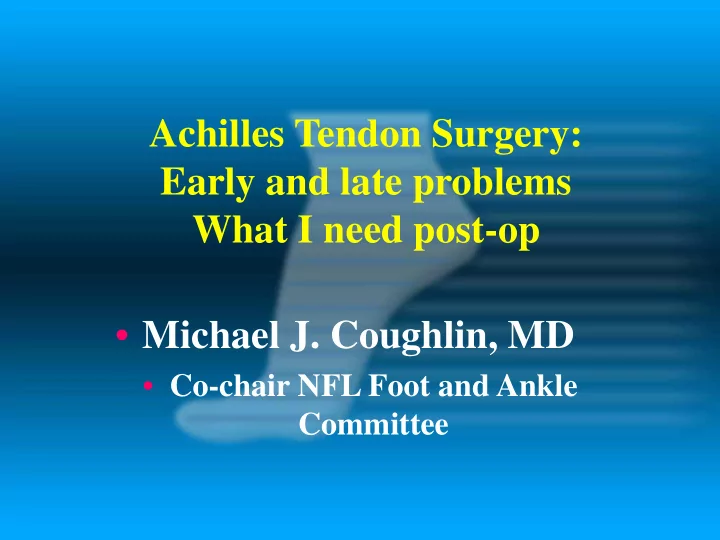

Achilles Tendon Surgery: Early and late problems What I need post-op • Michael J. Coughlin, MD • Co-chair NFL Foot and Ankle Committee
Anatomy • Gastrocsoleus – Largest muscle in the calf • 5-10 mm. thick at level of supramalleoli • 1.5-2 cm. wide – Zone of avascularity – Rotates 90 degrees • Spiral allows elongation and recoil – Paratenon-little vascularity
Younger patient -less than 25 years- -rupture- • Hyper-pronation • Tight Achilles • Faulty footwear
Area of rupture -the same area as tendinosis in older patients \
Rupture of the Achilles Tendon The most common injury method is caused by a rapid dorsiflexion force during a jump or running push off which overstretches the tendon causing it to tear
David Beckham Achilles Tendon Rupture
Achilles Rupture Demographics Ruptures peak in 2 nd , 3 rd and 4 th decades. Men > women Results from: Raikin SM, Garras DN, Krapchev PV. Achilles tendon injuries in a United States population. Foot Ankle Int 2013;34(4):475-480 .
General population – Football much smaller segment Results from: Raikin SM, Garras DN, Krapchev PV. Achilles tendon injuries in a United States population. Foot Ankle Int 2013;34(4):475-480.
Achilles Ruptures in the NFL 2010 – 2014 Total Achilles Tendon Ruptures = 66 players Preseason = 33 ruptures Regular Season = 31 ruptures Postseason = 2 ruptures
Most Common Activities – Cut/Change in Direction = 22 injuries – Sprinting/Running = 17 injuries
Unanswered questions: • Do they return to prior condition, strength, and performance? • Age and conditioning-a factor?
Does small exposure and dissection mean better recovery and better performance
Pars technique
7/9 returned to play at 6 months
The problem • These don ’ t hurt much • The patient often doesn ’ t get it • Can re-injure due to lack of cooperation
Postop treatment • Week one PF splint • Week 2-3 drop out cast
• Wt. bearing at week 5 • Boot at week 4 with heel lifts • Out of boot gradually at week 10
Why do we choose to operate? Mark Glazebrook MD SUTURES give strength! Resist Aggressive or reckless Rehab Especially weeks 2-12
Achilles Rupture: Primary Operative Treatment Is the Dissection & Blood Supply Stripping Worth it ??? Complications Higher ~ 3 x Higher for OR
Non-operative Achilles Rupture Treatment M.Glazebrook
Results Primary outcome: Complications -Surgery 13, Non-surgery 2 • NO Significant Difference in Re- rupture: – Operative 2 of 72 – Non Operative 3 of 72 MG
Serious Complications Less Frequent but real!! MG Infection, pulm. embolus
Conclusion: This study provides Level I Support: 1. Accelerated functional rehabilitation and Non operative treatment for Achilles tendon ruptures. 2. Application of a nonoperative protocol will avoid complications MG
Is the pendulum changing? MAYBE?
Older patient > 25 years- • Intrinsic tendon problem
Thick tendon -mid-substance tendinosis or rupture- • Etiology – Extrinsic stress – Degeneration – Microtrauma • Aging tendon is at risk!
Force across the Achilles (6-10 times body weight) Mann mathamatics • Walking 1 mile = 63 tons a mile • Running 1 mile = 110 tons a mile • Running a marathon = 2860 tons (For a 150 lb person)
Clinical findings
Pathology • Aging process and extrinsic stress • Inflammation, degeneration and microtrauma • The aging tendon is at risk!!!
Radiographic findings Calcification in the tendon!
Operative treatment WHAT IS THE PROBLEM?
Early problems –less than 4 weeks- • Rupture and repair – Infection – Wound dehiscence – Wound slough – Re-rupture
Eradicate infection • Antibiotics • Debridement • Skin graft • Wound vac
Wound sinus
Clostridia infection Courtesy A. Younger M.D.
Intermediate problems - between 4-12 weeks- • Draining sinus tract • Re-rupture
Late problem- Old rupture
Late problems 12 weeks • Over lengthening (stretching out) • Re-rupture • Tendinoses
History and Physical exam • Pain in area 2-6 cm proximal to insertion • Infection • Weakness, atrophy • Painful scar • Inadequate skin coverage – -an unforgiving area • Over-lengthened or incompetent Achilles
Conservative care • Brace • AFO
Conservative treatment • Below knee cast
Preventative treatment • Prevention • Full thickness skin flaps • Placing the foot in equinus in the cast initially
Surgical treatment - Principles of salvage- • Keep an intact musculo- tendinous unit • Use of substitute tendon as a scaffolding for the tendon repair • Advance all or part of the Achilles tendon
Surgical treatment • Tendon transfers – FHL • Gastrocsoleus “ plasties ” – Turn down flap – “ V-Y ” plasty
FHL transfer • Distal tendinoses
Tendinoses? • Is tendon salvageable?
Tendon resection
FDL Tendon transfer
Tendon turndown
Comprehensive resection and reconstruction!!!
Turn-down flat
“ V-Y plasty ”
“ V-Y ” plasty J. DeOrio MD
Single incision technique
Harvest the tendon, just above the tunnel
Using the fiber loop to secure the tendon
Size the tendon
Drill pin out the plantar aspect
Drilling hole with ACL reamer
Passing the suture, and then the tendon
Secure with appropriate tendon with biotenodesis screw
Post-op care • Immobilize in cast for 6 weeks • Partial weight bearing at 3 weeks • Cam-boot, FWB with ROM at 6 weeks • Jogging, speed walking -12 wks
Wound problems
Successful healing
Post-op care-following reconstruction-these are slower! (major P.T. work to rehab the calf) • Ankle in 10 ° equinus • Neutral at 4 weeks • Wt. bearing at 4-6 weeks • AFO at 12 weeks • Athletics at 6 months
Two more points – Active quad sets, leg lifts immedicately post op and going forward – Anti-coagulation (ASA usually)
Complications • Infections-disasterous • Delayed wound healing • Aggressive PT post-ops • Tailor surgery to the individual – Magnitude of problem – Duration of symptoms
Recommend
More recommend